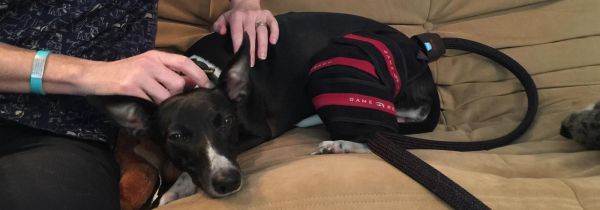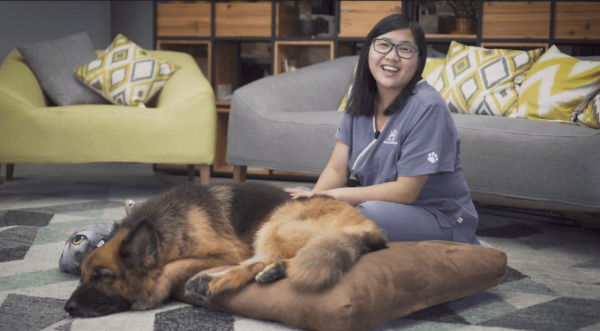
Muscles and Soft Tissues: Strains and Sprains

These types of injuries often occur during rigorous activity or abrupt movement such as when your dog jumps from the couch, or steps into a hole or slips. However, they can also be chronic, long term issues that grumble on and slowly get worse.
We commonly treat dogs, cats and rabbits suffering from strains and sprains. The initial phase of rehabilitation treatment is to manage pain and slowly re-establish normal movement to the affected area. Physiotherapy will help support the associated soft tissues - muscles, tendons, ligaments, which are affected in addition to the bones or joints.
Rehabilitation is also aimed at identifying and treating any compensating movements or changes to normal mobility that the pet makes in order to cope with their disability. We use specific techniques to encourage normal use and alleviate these secondary or associated changes.
Whether conditions such as muscle tears, MSI and torn CCL are treated with surgery or conservative management, physiotherapy and rehabilitation are an integral part in successfully improving your pet’s recovery.
Iliopsoas and other muscle strains
Some muscles are prone to repetitive strain. One of these is the iliopsoas muscle group. Made of two muscles together (psoas and iliacus) which run along the inside of the spine and towards the inner back leg, this muscle helps to flex the hip. It is commonly injured if the pet’s back leg slips or slides out to the side on a slippery floor. In older pets this can be a repetitive strain problem.
Cranial cruciate ligament tears
In dogs, the knee (stifle) joints are particularly vulnerable where one of the most common and serious injuries is a torn cranial cruciate ligament (CCL) which makes the joint unstable for walking and painful!
Medial shoulder instability
In the front leg, medial shoulder instability (MSI) or medial shoulder syndrome is all too common in small breed dogs. The dogs’ shoulder joint is only stabilised by soft tissue structures, such as the joint capsule, ligaments and tendons, so if any of these parts becomes unstable, like a torn knee ligament, it becomes very painful and limits your pet’s ability.
These soft tissue and muscle conditions can cause pain, weakness, decreased range of motion and flexibility, reduced strength and endurance and difficulties with normal activities. Look out for early signs:
Often if multiple legs are affected, it can be very difficult to see obvious signs of lameness, and instead you may just notice your pet is reluctant to move or play, less willing to walk, or stiff after resting. Cats will often reduce their activity, change their behaviour or change the usual places they like to rest (because they are easier to get to).
All our therapies are non-painful and non-invasive. Therapies vary depending on your pet, their needs and condition.

Thermal therapy is the application of hot or cold temperature to the body to relieve pain and control of inflammation. Cold therapy is ideal for the acute phase of injury (first 72 hours) to reduce pain and swelling. Heat is useful in chronic injuries, where it can increase blood supply and provide pain relief.
More about Thermal Therapy
Therapeutic laser uses invisible infrared light energy (photons) to penetrate deep into tissues and enhance tissue healing. Laser therapy can be used to help rehabilitate patients with musculoskeletal pain, tissue swelling, inflammation, muscular strains and sprains, tendonitis and joint pain.
More about Laser Therapy
Many specialised ‘hands-on’ techniques are used by our veterinary therapists to assess and treat soft tissue abnormalities, muscles tightness and trigger points, joint restrictions, and stretches. The techniques vary depending on the injury and area.
More about Manual Therapy
Therapeutic massage is used to treat muscle tension and tightness which is very common. It includes a variety of techniques such as effleurage, petrissage and trigger point release.
More about Therapeutic massage
Exercises are designed to be muscle and joint specific and comprehensive. Important factors to be considered include the type of injury, tissues involved, tissue healing time, age and ability of the pet. Exercises that encourage joint range of motion and work to strengthen the injured muscles are added into the rehabilitation programme. To prevent re-injury, pre-exercise stretching is key. Various training equipment is utilised to match your pet’s needs and ability.
More About Therapeutic Exercise
Antioxidants and supplements can help to repair damage to the cells in the body and are extremely useful in improving joint health and comfort and helping to protect the joint structures from further degeneration.
Buy Supplements
Ultrasound waves are created by sound energy and can be used for therapeutic response as well as diagnosis (such as scanning the abdomen or heart). This can be very effective to help rehabilitate patients with musculoskeletal pain and soft tissues injuries of the muscles, tendons and ligaments.

The Stance Analyser quantifies your dog’s weight distribution through each leg to provide an accurate reading and removes the guesswork involved. The readings help to identify problem areas as part of the physiotherapy consultation and we can monitor your pets' ongoing therapy and response. This is a fast, simple and non-invasive way to monitor your pet’s stance.
More about Stance AnalyserOur process for muscle strains and sprains.
Initially we need to collect as much information as possible about your pet and your concerns; we will send you a detailed online questionnaire to complete. We will also reach out to your family veterinarian and /or specialist for your pet’s full medical history.
At our physiotherapy initial consultation, we assess the gait and movement of your pet, review the medical history and perform a thorough physical assessment to determine which parts of the neurological and musculoskeletal systems are affected.
Working together with you, we then devise a physiotherapy and rehabilitation treatment plan which meets the needs and goals of your individual pet. The treatment plan will generally include a variety of therapies and home care for you to continue at home, alongside our treatments.
Regular physiotherapy re-assessments are made throughout the treatment period to ensure your pet is progressing well with their rehabilitation and to update any home exercises prescribed. The frequency varies depending on your pet’s needs.
"Thank you for not only taking care of Fensi's joints and muscle problems, but also for noticing her lumps along the mammary glands so we could have them removed just in time!"
HK$ 2880
HK$ 2580
HK$ 8880
HK$ 530
Is your dog is reaching their senior years?
We wanted to let you know that Paws in Motion has a BRAND NEW online course to help your senior dog maintain the best possible quality of life.
The course is currently at a discounted introduction price and we have worked hard to pull together more than 4 hours of training on how to understand and minimise the effect of your pet's aging.




